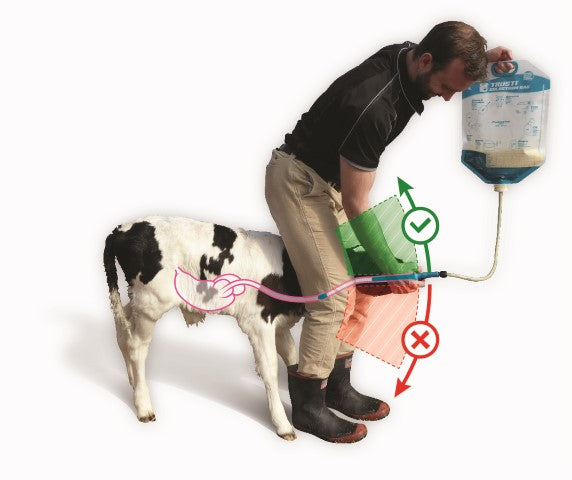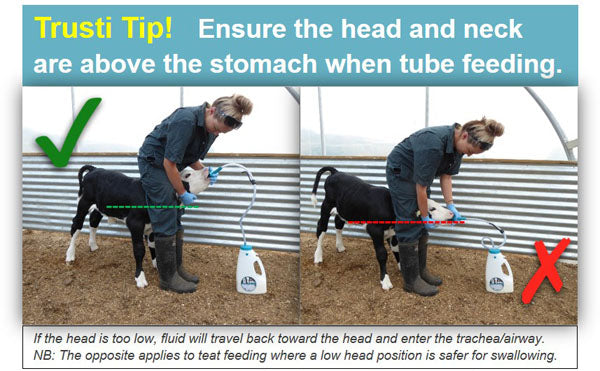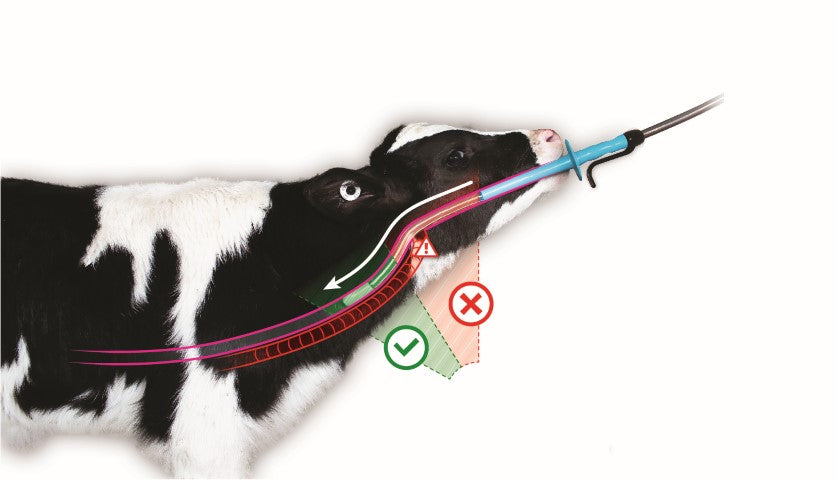Frequently Asked Questions
Here you can find some answers to the most frequently asked questions we receive.
If you have a question that has not been answered on this page then please contact us via sales@shoof.co.nz and we will be happy to help you.
How do I tube feed safely to avoid drenching liquid on the lungs?
- Handle your calf and pass the tube gently – if the calf is comfortable and no force is involved it is very difficult for the tube to enter the airway.
- Pass the tube beyond the airway entrance (throat) and ensure it stays there during fluid flow.
- Ensure the calf’s head and neck stay above the level of the stomach throughout feeding.
- For certainty of tube position, learn how to see or feel for the tube tip within the oesophagus
Concentrate during feeding, monitor your calf so you can recognise when something is not right and be prepared to lower the bottle and stop flow if need be.
Please watch our anatomy video which shows the important parts of a calf involved in tube feeding, it is great for removing the mystery of the procedure. We also have other carefully prepared information to assist with tube feeding as safely as possible Please also watch our demonstration video. If in doubt ask your friendly veterinarian to show you how to use, how to double check correct positioning and how to recognise a problem.
Note: If usign your Trusti Tuber to feed larger animals (Can be used to rehydrate sick animals up to 200kg), the airway entrance is larger which means the chances of entering the airway by accident increases. The airway entrance is located underneath the oesophagus and in the centre of the pathway, so if you direct the tube to either the left or right side of the throat the tube will pass around the airway.
Safe head height when calf drenching: Maintain the head and neck above the stomachs.


Safe tube position when tubing a calf: Maintain the tube beyond the airway entrance (the throat).

How can I buy?
To purchase Antahi products visit Shoof International
How many ml/oz do I tube feed a lamb or kid?
When using a lamb feeding tube, a good rule of thumb is 50ml per kg or until the tummy feels full. For example a 3kg lamb 150ml (5 ounces), a 4kg kid 200ml. You can do this four times per day. If you are uncertain about how much the lamb or kid has already consumed then it is safer to reduce this volume. Feeding as soon as possible after birth with the best quality colostrum (high antibody concentration) will ensure the greatest antibody absorption for maximum immunity and health.
What is the best calf drencher or best calf fluid feeder?
The difference between the Trusti and Flexi Tuber is the mouthpiece design. The mouthpiece is the piece that protects the flexible tube from the sharp teeth, keeping the tube nice and smooth to avoid scratching the trhoat and oesophagus. Both mouthpieces are designed to be easily held in place with one hand. The Trusti Tuber has a circular guard which sits against the muzzle in a position similar to a baby’s pacifier. The Flexi Tuber mouthpiece has a soft cross bar which sits in the corners of the mouth, similar to that of a bit on a bridle. The crossbar also has high wings to keep the mouthpiece central and has the option of using a head strap to secure it in place.
Farmers report both options to be much more pleasant to use than rigid tube feeders and within farms there may be one person who prefers the Flexi tuber and one person the Trusti tuber. Both designs can be used interchangeably with the same 4l Antahi Feeder bottle and replacement tubes. Whichever you choose, your calves will thank you for it.

What is the best position for tube feeding or drenching a calf?
- Ensuring the calf is secure so it cannot move into a dangerous position
- Keeping the head and neck above the stomachs so the liquid can flow by gravity down toward the stomachs and not back toward the throat where it will fall into the airway
- Being able to safely hold the tube in position throughout feeding
The most preferred position is with the calf standing and straddling the calf to hold the head secure. In this position be certain the head and neck are held high enough. If you are shorter or wearing multiple layers of leggings, be sure you are not pushing the neck or head lower than the stomach.
Feeding in a sitting position is also safe provided the calf is sitting up (not lying out flat) so the head/neck are above the stomach. The sitting position is recommended for calves that look like they will stay in a safe sitting position, not with a calf that looks like it could jump up suddenly.
Some people like to sit the calf on its rear with its back leaning against the handler, similar to when trimming the hooves of a sheep. This is also a safe position.
Excellent standing position – head and neck above the stomachs:

Recomended sitting position – calf sitting up with head and neck above the stomachs:

How do I clean my calf drencher?
Clean soon after use for best results. First rinse with cool or lukewarm water to remove milk residue then clean with warm soapy water to remove milk fat and protein. Hang to airdry.
Easy clean material ensures your fluid feeder can stay in good condition for longer. The 4l Trusti bottle has been designed so you can fit a bottle brush down the handle to clean those normally hard to reach places. Another tip is to sterilise with Milton tablets after thoroughly cleaning with warm soapy water.
Do not soak in acid, this may disintegrate the product and reduce its life span.
We highly recommend to have separate feeders for newborn calves and for sick calves.
How do I increase or decrease the flow speed?
The Antahi bottle is equipped with an automatic air valve, so flow results from simply lifting the bottle above the calf’s head. Lower the bottle to slow or stop the flow. Flow should be easy with a satisfying bubbling sound.
Slow flow is possible if:
- The colostrum is lumpy and blocks the tube
- There is a foreign body blocking the tube
- Colostrum has been left to sit forming cream lumps on the surface
- Some electrolytes form a jelly like substance, if you are using one of these types through the tube feeder ensure you feed immediately after mixing, and wash the tube immediately after use.
Remember you can always quickly stop flow by lowering the bottle.
Where do I position the black sleeve?
Even if your calf is only 20kg you can safely pass the tube to the 100kg mark however this becomes more uncomfortable for the calf, hence the guides.
When feeding a group, set for the largest calf in the group. For example, if you are feeding calves ranging from 20 to 50kg we would recommend you set the sleeve to the right of the 50kg mark (see image).
DO NOT set the stopper to the left or the close side of the mark, this will reduce your safety margin resulting in the tube being closer to the airway entrance.

How big is my calf?
The Antahi Tubers are suitable for use in calves and weaners up to 150-200kg. The calf size markers are a guide which means you do not need the exact calf size to use the product. If unsure, pass the tube further down i.e. to a heavier weight, to ensure you are safely passed the throat (airway entrance), as it is always better to pass the tube farther than not far enough. For older calves, weaners and yearlings, this depends on growth rate and you will have an idea of size relating to weaning weight and by monitoring weight gains. If you do not have weigh scales then weigh bands are a low cost and useful aid for monitoring your calf weights.
Here is a calf size guide for appropriate minimum fluid feeder positioning:
| Newborn |
|
10 weeks (or at weaning) | ||
| Jersey | 25 | 50 | 80 | |
| Jersey x Friesian | 35 | 60 | 90 | |
| Friesian | 45 | 70 | 100 |
The tube stiffens in extreme cold, what do I do?
Warm the tube up to make it more comfortable for the calf. The tube will soon soften with body temperature however it is recommended to warm and soften the tube for the first calf.
Do I need to kink the tube before removing from the calf?
No you do not need to kink the tube because the tube is transparent you can see the liquid flow through. You do need to ensure all liquid has passed through the tube prior to removal. To be safe it is best to wait for at least one second after fluid has passed through before removing. Always remove gently.
Are antibodies absorbed as well when feeding with oesophageal feeders vs suckling?
This is a very good question. When suckling, the colostrum is diverted straight to the abomasum (4th stomach) whereas with tube feeding the colostrum is delivered to the forestomachs (1st and 2nd stomachs). So you may think that it could take longer for the antibodies to be absorbed. A study by Elizondo-Salazar et al. 2011 decided to prove one way or another – and they found absolutely no difference in total antibodies absorbed between the two methods. The forestomachs of a newborn calf are small and undeveloped therefore colostrum delivered via a tube overflows into the abomasum. Another study found there was a difference if the volume fed was small e.g. only one litre. This is because around a cupful of liquid may stay in the first stomachs resulting in only 3/4 litre over flowing.
In conclusion, ensure the calf is provided with a full feed and there is no difference. Feeds of one litre or less are not providing enough colostrum by any method. The main focus is to get enough antibodies into your calves quickly, whether that is through bottle feeding or tube feeding, whichever the situation calls for. Time is the critical factor as every hour after birth the antibody absorption capacity declines.
Can feeding milk through a tube feeder can cause digestion problems?
Not in the very young calf. In the newborn or very young calf do not be concerned, the forestomachs are undeveloped and colostrum or milk flows quickly from the forestomachs (rumen) into the abomasum where it would normally go if the calf was suckling. When a calf suckles or nurses a teat or nipple there is a natural closure of a very clever groove (the oesophageal groove) which creates a tunnel by-passing the forestomachs so milk travels straight to the abomasum. When the calf is older, the rumen has begun developing and milk entering the rumen has potential to cause digestive problems due to the readily digestible and fermentable energy source. Therefore, practically this is something to keep in mind when you are helping a sick calf over 2 weeks of age (general age rule of thumb). If you are treating a scouring calf over two weeks of age:
- Reserve the calf’s energy for suckling the milk feed so you can be sure the milk enters the abomasum.
- Tube feed the electrolyte feeds because it does not matter which stomach the electrolytes enter.
- Provide anti-inflammatories which help the calf to feel better and therefore increase their appetite and suckling ability.
- Diagnosing the cause of scours will enable the most effective treatments and most rapid recovery.
- If your calf has not suckled milk after 36 hours on electrolytes it will begin to fade due to lack of nutrients – you will need to tube feed milk in this situation as the lower risk of poor digestion outweighs the higher risk of starvation.